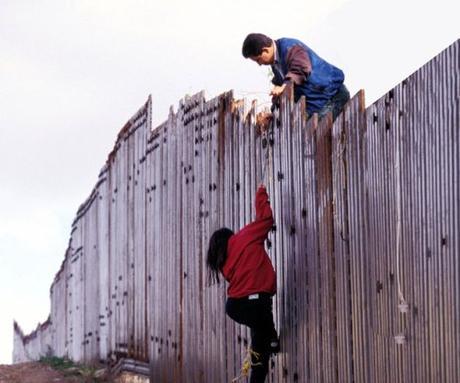
Tucson.com (NOGALES, Sonora): The 31-year-old Oaxaca native was dangling by one arm, a drop of more than two stories below her. Slowly, her hand slipped and her legs slammed the desert floor with a bone-rattling thud. She couldn’t move. All she could think about was the 14-year-old daughter she had left behind — whom she might never see again.
Reports of migrants getting hurt when trying to jump the fence or trekking through the treacherous desert are not new, but immigrant shelters and Mexican officials are seeing a spike of migrants — especially women — getting hurt trying to jump the border fence. They think, incorrectly, that the jump will be easier than making the treacherous trek through the 100-degree desert.
“It’s the same crossing through the wall or through the desert,” said Gilda Felix, director of the Juan Bosco immigrant shelter in Nogales, where many of the injured are brought before going home. “Both are difficult and dangerous.”
This year the Mexican Consulate in Tucson has seen more people needing medical attention after falling from the border fence than from crossing the desert, said Ricardo Pineda, the consul general. So far this year, there have been 37 cases of injured Mexican migrants. In all of 2014 Pineda’s office reported 56 cases. That includes all injuries, not just falling from the fence.
The Juan Bosco shelter is averaging about 20 to 30 injured men and woman a month, most of them with foot and spine fractures. One recent day Felix had three women with foot injuries. “There always have been people crossing this way,” Felix said, “but now as the summer starts and it’s not cold, people want to cross.”
COSTS HARD TO TRACK
Area hospitals are responsible for much of the cost associated with treating injured border crossers, but most don’t keep track of how many there are or of the cost.
Many of the less seriously injured go to Holy Cross in Nogales. When the injuries involve trauma, patients are taken to Tucson, either to University Medical Center or Tucson Medical Center.
Banner-University Medical Center doesn’t specifically track falls from the border fence, but Border Patrol agents bring in about 50 crossers a year with fall injuries, said Katie Riley, a hospital spokeswoman. They include falls from the wall as well as in the desert. Most are fractures and lacerations. The charges vary depending on severity of injury, she said. “We bill these patients, but few are able to pay anything, so most of the charges are written off.”
Tucson Medical Center doesn’t track the immigration status of its patients, hospital spokeswoman Rhonda Bodfield said. In 2014, TMC provided $13.6 million in uncompensated care costs, which includes charity care, bad debt and discounts for the uninsured. Until several years ago, the federal government taxpayers reimbursed hospitals for a small fraction of those expenses, but that source of revenue no longer exists.
Border Patrol agents regularly rescue injured migrants, officials said, but the agency does not keep data on injuries caused by falling off the fence.
The numbers of those who get hurt while trying to illegally cross into the United States ebbs and flows, said Fernando Valdez, Mexico deputy consul general in Nogales.

“What surprises us is that people continue to jump from heights that can be the equivalent of a two- or even three-story house,” he said. “But we hear they feel pressured to do it because they are holding the line or (the smugglers) start insulting them, telling them to jump.”
The 31-year-old from Oaxaca, who asked not to be identified because she fears for her safety given the connection between smugglers and organized crime, said she chose the Nogales route because she was told it would be easy. “I got here on May 8, a Friday, and they told me ‘by Sunday you’ll be with your family,’” in Los Angeles, she said from a bunk bed at Juan Bosco — one of her legs in a cast and the other being held in place by metal rods. She had been there for 20 days.
When the smugglers she hired told her it was her turn to cross, she climbed the ladder — for which she paid roughly $13. But once she was on top she couldn’t figure out how to come down and slipped. One of the guides tried to grab her hand as she held on with the other. She lay on the ground for two hours until a Border Patrol agent spotted her. She had broken both legs and her spine.
A DREAM ENDS
For some, the fence is a last resort. Maria Ibarra, 28 and also from Oaxaca, had tried crossing through Nogales and El Paso in April, but both times she was sent back to Mexico.
This time she was determined to get through. She left her 10-year-old son with her parents in Oaxaca. He was born in South Carolina, where she lived for two years before going back to Mexico in 2006 so her parents and siblings could meet her son.
Once there, she said, her son started losing his hearing in one ear and having seizures. “All I wanted was an opportunity to fight my case,” she said. She hoped her son could join her or maybe she could get a permit to visit the hospitals where he was first treated. But she already had a couple of deportations and a voluntary return to Mexico.
On June 20, she was taken to the border fence and given a ladder. Her foot got caught in the bollard-style fence and she lost her balance. At first she thought everything was fine, but then realized she couldn’t stand. She dragged herself to a nearby home and tried to hide from the Border Patrol. “I knew I had broken something but it never crossed my mind it would be this serious,” she said.
Eventually the Border Patrol found her. “As they came in tears started to roll down my cheeks,” she said. “I was broken, immigration was there. I had no way out.” She was taken initially to Holy Cross but her injury was too severe and she was transported to Tucson for surgery to reconstruct her foot.
Both women flew back to Oaxaca with the assistance of the Mexican consulate on Tuesday. “I will tell my people not to come, not through the desert nor the fence,” said the 31-year-old with two broken legs.
She’s looking at a six-month recovery before she can walk again, but now she can’t work to pay for the needed therapy and continued medical care. “We come with the hope of a better life,” she said. “It’s a nice dream, but when something like this happens, everything comes tumbling down.”

DCG

